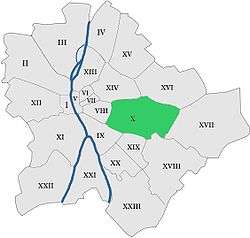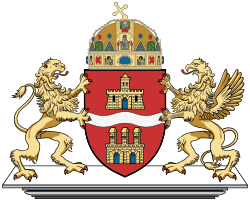Kőbánya

Kőbánya (literally: Quarry, German: Steinbruch) is the 10th district of Budapest (Hungarian: Budapest X. kerülete) and one of the largest by territory. It is located in southeast Pest, easily accessible from the downtown by Metro 3, whose terminus is named Kőbánya-Kispest.
It has strong industrial and organized labour traditions and has suffered much setback after the collapse of Socialism in 1989-90. Today, the district is rebuilding itself into a living area for the middle classes. Due to its large size, there are several diverse areas within Kőbánya, each with different architecture.
History
The Kőbánya area was historically used to mine limestone for buildings in Buda and north-west Hungary. The extensive and often un-plotted tunnel network that was created during the past five centuries is a major source of problems today, causing buildings to sink and roadbeds collapse. There were also clay-mining pits for the brick industry. Most of these holes have been filled with urban garbage during the 20th century, then covered with soil and built upon, which also causes problems today. As an exception, one of the holes became a fishing lake due to collapse.
A third venue of economy in Kőbánya was wine-making, until the vineyards were destroyed by the Phylloxera disease at the end of the 19th century. A building which exemplifies the historical heritage of Kőbánya is the "Csősztorony" (a small vineyard watchtower) in the middle of the Óhegy area. The district recovered when beer-making enterprises moved into the area and the light beer "Kőbányai Világos" became a kind of national drink during the socialist regime.
The historical Rákosmező area, whose exact location is no longer known, used to be the only legal tent site for feudal parliamentary sessions throughout the medieval ages. It is only known that it was alongside the small Rákos stream, which runs into the Danube river.
The barren new Rákosmező area (now a traffic junction near the beer factory) used to be the proving ground for Hungarian aviation pioneers around 1909-1912. Even Louis Bleriot flew there once during an air race.
Geography
Kőbánya lies mostly on plain. Óhegy and Újhegy (literally Old- and Newhill) are two higher-standing areas, roughly at the height of Gellért Hill on the other side of the Danube river. Óhegy is 148 m high.
Demographics
Kőbánya is a largery working to middle class, mostly ethnically Hungarian neighborhood (90,3%). There is a significant Roma (Gypsy) presence in the district (1%), mostly scattered evenly over the entire district. As of recent, a number of small but visible immigrant communities are also springing up, notably the Chinese (0,6%). (2001 census)
Economy
Presently Kőbánya has the pharmaceutical industry (the Egis Nyrt. and the Richter Gedeon companies), and beer manufacturing (Dreher) to be proud of. Manufacturing and the chemical industry collapsed when socialism fell. Much tax evasion is still going on in the district, which hurts the district and the country.
Description
The centre of Kőbánya has a beautiful Catholic church built in late 19th century eclectic-Art Nouveau style, dedicated to knight-king St. Ladislaus. It has a very tall bell-tower and the church's roof is covered in patented colorful Zsolnay "eozenic" porcelain tiles which were designed by Ignatz Oppenheimer. Next to it lies the "Pataky" culture centre and library, and the secondary school, also dedicated to King Ladislaus. It specializes in biology and languages (especially Italian). Many elementary schools in Kőbánya have been closed in recent years due to dwindling birthrate. On the opposite side of the church the "Mázsa tér" square is set to become a small high-rise are with six 60-meter tall apartment towers. The Budapest general assembly or the Ferihegy airport authorities are considering blocking this ambitious plan.
Újhegy have been covered with a vast housing estate of 10-story concrete houses during the 1970s and 1980s. A very large area of Kőbánya land near Újhegy is occupied by a prison and the New Public Cemetery (perhaps the largest in Europe). Other large open spaces, namely the horse-racing circuit and the Expo area (used for international trade fairs during the communist era) will be relocated outside the district to allow for housing projects.
In the north-east corner of the 10th district is a large fashionable shopping mall called Árkád on the Örs vezér tere traffic junction. In the south-east corner is a public sporting park (Sportliget) with indoor swimming pool and a small but very deep fishing lake. In the north-west corner is a large public park called Népliget, which has been in poor shape since 1990, due to social outcasts drawn there by the intercity bus junction. A large Planetarium is located in the park. The south-west corner of Kőbánya hosts the terminal station of the M3 underground line and a large mass transit junction. This area is inhabited by many homeless people.
Politics
Kőbánya has had a socialist party-dominated municipal assembly since 1990. Before 2002 the mayor was a member of the Christian Republic party. At that time a socialist bureaucrat became mayor. The inefficient and in-fighting Kőbánya council has become a symbol of corruption and feud, both too common to Hungarian politics. Kőbánya recently has been drawn into a financial and political scandal, domestically known as the "broker scandal" and lost huge investments, pushing the district into great debts. After much political manipulation, some of this sum was recovered, when the affected bank decided to pay to keep the even nastier issues under wrap.
Sport
Twin towns
Kőbánya is tinned with:
See also
Gallery
External links
Coordinates: 47°28′35″N 19°8′35″E / 47.47639°N 19.14306°E









